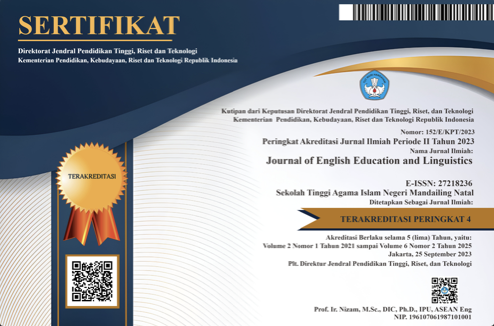The Use of Gesture to Overcome Misunderstanding in Teaching English
DOI:
https://doi.org/10.56874/jeel.v3i2.915Keywords:
Gestures, Non-Verbal Communication, Teaching EngliAbstract
Gesture is a type of non-verbal communication that is very influential in teaching and learning activities and interactions between teachers and students. It is not only can convey the speakers’ intention more specifically and adequately, clarify the teaching instruction, encourage the students’ interest, maximize English teaching’s goal but also can help improve the students’ skill in speaking, writing, reading and listening . This study aims to improve students' speaking, writing, reading, listening and interest in English lessons through the use of gestures at SMA Negeri 1 Batang Natal.The method used was descriptive qualitative. The subjects were 2 teachers and 25 students of 11th grade of SMA Negeri 1 Batang Natal The research instruments used were interviews and observations. The results of this study suggests that the use of movement has positive and negative sides for students. The positive side is that the teacher must be able to use the right movements according to the needs of their students. Creating a comfortable atmosphere and considering the most effective method so that students are activated in participating the lessons. While negative side was using too many movements or being too serious when teaching would not create a comfortable classroom atmosphere.
References
Adler, R. B., & Rodman, G. (2006). Understanding Human Communication. New York: Oxford University Press.
Ainun Nur Farlianti, Roslina & Hariadi Syam. (2017). Analysis of Gesture Used By The Students of English Study Program in The Classroom Interaction At The University Of Sembilanbelas November Kolaka Educatio : Journal Of Education 2, no. 2:202
Alibali, Martha W et al. Language and Cognitive Process. Gesture and the process of speech production: We think, therefore we Gesture, 15 (6), 593-613.2000
Dobrescu, T., & Lupu, G. S. (2015). The Role of Nonverbal Communication in the Teacher- Pupil Relationship Procedia - Social and Behavioral Sciences, 180, 543-548. doi: 10.1016/j.sbspro.2015.02.157.
Dubin, F. & Olshtain, E. (2002). Course Design. Shanghai: Shanghai Foreign Language Education Press.
Farlianti, A., Roslina, R., & Syam, H. (2017). The Analysis Of Gesture Used By The Students Of English Study Program In The Classroom Interaction At The University Of Sembilanbelas November, Kolaka. EDUCATION: Journal of Education, 2(2), 201- 2014. https://doi.org/10.29138/educatio.v2i2.16
Grandhi, S. A., Joue, and Mittelberg. Undertanding Naturalness in Production: Insights for Touchless Gestural Interfaces. Natural Media and Engineering, HumTec. Germany: RWTH Aachen University, 2011.
Hidayat, S. (2013) An analysis of Students’ Body Language Response to Teacher Talk at Speaking. Class in UIN Alauddin Makassar. Thesis, Makassar: The State University of Makassar.
Jaskolka, Anna. The Picture Book of Body Language; The Only Language in Which People Can’t
Lie. England: Martins the Printers Ltd, 2011.
Kendon, A. Language and Gesture: Unity or Duality? ed. D. McNeill, Language and Gesture.
UK: Cambridge University Press, 2000.
Kendon, A. Language and Gesture: Unity or Duality? ed. D. McNeill, Language and
Gesture. UK: Cambridge University Press, 2000.
Nurpitriyani, Nita. Penggunaan Gesture dalam Pembelajaran Membaca Pemahaman Bahasa
Inggris di Sekolah Dasar. 2014
Pease, A. Body Language; How to Read Others’ Thoughts by Their Gestures. London: Sheldon
Press, 1988.
Saenong, Ahmad. ―The Usage of Nonverbal Language in Communication. Thesis,
Makassar: The State University of Makassar, 2008.
Yule, George. (2010). The Study of Language. Cambridge: Cambridge University Press.
Downloads
Published
Issue
Section
License
All articles published in the Journal of English Education and Linguistics are licensed under a Creative Commons Attribution-ShareAlike 4.0 International (CC BY-SA) license. This means anyone is free to copy, transform, or redistribute articles for any lawful purpose in any medium, provided they give appropriate attribution to the original author(s) and Journal of English Education and Linguistics, link to the license, indicate if changes were made, and redistribute any derivative work under the same license.
Copyright on articles is retained by the respective author(s) without restrictions. A non-exclusive license is granted to the Journal of English Education and Linguistics to publish the article and identify itself as its original publisher, along with the commercial right to include the article in a hardcopy issue for sale to libraries and individuals.
Although the conditions of the Creative Commons Attribution-ShareAlike 4.0 International (CC BY-SA) license do not apply to authors (as the copyright holder of your article, you have no restrictions on your rights), by submitting to the Journal of English Education and Linguistics, authors recognize the rights of readers and must grant any third party the right to use their articles to the extent provided by the license.

This work is licensed under a Creative Commons Attribution-ShareAlike 4.0 International License.








